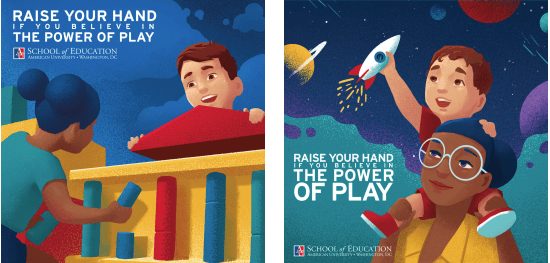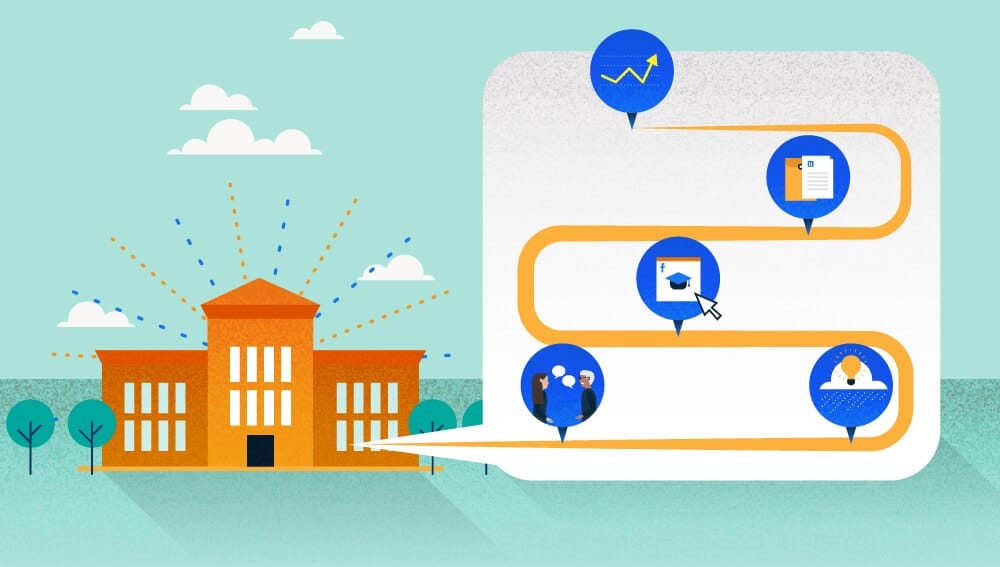How to Tell Stories on Facebook With Ad Copy That Works
With 67% of marketers citing Facebook as the most preferred social media platform, it’s the go-to advertising tool for many college and university marketers. Yet the click-through rate (CTR) for Facebook education ads (0.73%) underperforms the average CTR for Facebook ads across all industries (0.9%) according to benchmark data from WordStream. Clearly, there’s room for improvement.
So, as a copywriter, how do you improve your CTR? Anyone tasked with developing ad copy for Facebook has likely asked a few common questions:
- How long is too long?
- Should I use paragraphs or bullet points?
- Is it OK to use emoji? ?
What’s the secret to writing good ad copy on Facebook? The short answer is there is none. The effectiveness of ad copy is entirely dependent on what you’re writing about and who you’re writing for, so the rules for what works and what doesn’t are fleeting. Having a laser focus on your topic and target audience — whether it’s college-bound teens, their parents, or professionals returning to school to advance their careers — is critical to creating relevant, impactful social ads.
With Facebook generating upward of 98% of its revenue from advertising, according to CNN Business, its users are bombarded with ads and becoming more adept at tuning them out. Higher ed marketers aren’t only competing against other institutions and degree programs — they’re vying for the limited attention of ad-weary scrollers against an avalanche of promotional material.
How do you craft copy strong enough to break through to tuned-out Facebook users? Start by making an emotional connection with your target.
Tell an Emotional Story, but Don’t Lose Sight of Tangible Benefits
Impactful ad copy sinks its hooks into readers and reels them in by telling a story. The best way to convert views to clicks is to formulate narrative-driven, emotional copy that speaks directly to your target audience. While nobody expects your ad to rival the drama and excitement of Watchmen, successful Facebook ads cut through the digital clutter by connecting emotionally with the reader.The essential elements of good Facebook ad copy include a character (in higher ed, usually a prospective student), the stakes or goal for that character, and a clear path for reaching that goal (usually your product or service, such as a degree or certificate). Copywriters also must weave tangible value propositions and outcomes into these brief stories. If this sounds like a lot to pack into a small space — especially on a mobile device — it is. But don’t be discouraged. By focusing on the following steps, you can craft Facebook ads that get results.
Craft a Story
- Introduce the character. Present the role the character (usually the desired customer) plays in the stakes surrounding your product or service.
- Establish context. Tell the reader about the landscape in which your product or service exists and why your product is important to that landscape (i.e., create stakes or a desired outcome).
- Introduce the stakes/goal for the character. Explain what your character wants to do or accomplish.
- Reach the goal. Outline how your product or service helps your character attain their goals.
These steps are really a condensed version of the classic story structure known as the “hero’s journey,” coined by the American academic Joseph Campbell in 1949: The hero goes on a quest, faces challenges, emerges victorious, and returns home changed or transformed.
From Odysseus to Luke Skywalker, the hero’s journey has been told countless times throughout oral and written human history. It’s also an effective model higher ed marketers can use to craft aspirational ad copy that resonates with readers.
Emphasize Tangible Benefits
The best products solve problems and improve customers’ lives. With that in mind, to write good Facebook ad copy, consider the following best practices:
- Don’t lose sight of the clearly defined benefits of using your product or service.
- For the greatest impact, include these benefits when establishing how the character of your story reaches their goals.
- Remember to list as many concrete details as possible. For higher education, this typically refers to learning outcomes, courses, job placement rates, or challenges being tackled by potential students.
Archer Educaton’s expert storytellers are here to help university marketers pinpoint and emotionally connect with their target audiences. For instance, one ad campaign our copywriting team developed for American University’s Online Master of Arts in Teaching (MAT) program targeted a niche audience of prospective students — English teachers abroad — with an emotional appeal to their passion for teaching and desire to create a more equitable education system at home in the United States.
After casting an emotional hook, the copy emphasizes the tangible benefits of AU’s MAT program, including preparing graduates to become licensed teachers, equipping them with the skills to help their students thrive, and priming them to advance their careers.
Know Your Audience and Write Specifically for Them
 In his book “On Writing,” the master horror and fiction writer Stephen King advises all writers to have an ideal reader in mind. King’s advice rings just as true for Facebook ad copy as it does for his 1,153-page post-apocalyptic novel “The Stand” (although your ad copy hopefully will present the reader with a brighter future). The difference, however, is that copywriters should have multiple ideal readers in mind and develop specific stories for each one, whereas King writes stories only for his wife.
In his book “On Writing,” the master horror and fiction writer Stephen King advises all writers to have an ideal reader in mind. King’s advice rings just as true for Facebook ad copy as it does for his 1,153-page post-apocalyptic novel “The Stand” (although your ad copy hopefully will present the reader with a brighter future). The difference, however, is that copywriters should have multiple ideal readers in mind and develop specific stories for each one, whereas King writes stories only for his wife.
The more precisely targeted the copy, the more effective the ad will be.
Identify Your Audiences
- Keep an open mind. You might think you have just one type of ideal customer/reader, but you’re wrong. Scores of people from a variety of backgrounds can likely benefit from whatever it is you’re selling.
- Do the research. Find out who your customers are, why they chose to be your customers, and what they hope to do with your product or service.
- Get specific. Learn where your customers are in their careers, how educated they are, and whether they’re married or have kids. All these details will help inform your ad copy.
Higher ed marketers will want to create multiple personas — semifictional representations of their ideal prospective students — for their academic programs. The list can be surprisingly long. For example, an ad campaign we created for Pearson Accelerated Pathways’ online college program targeted 13 distinct personas including:
- Parents of home-schooled students
- Cost-conscious students
- Travel/tourism and service/hospitality professionals who have lost their jobs as a result of COVID-19
- Dedicated athletes
- English teachers abroad
- Artists/musicians
- Actors/models
- Students with learning disabilities
- Adult learners
Craft Messaging for Each Persona
- Once you’ve identified your ideal readers and gotten to know them, write each of them a story!
- Use the details you’ve discovered about each persona to craft copy that speaks to their specific needs and goals.
- Make sure your readers feel recognized and that you’re genuinely trying to improve their lives. They know you’re just trying to sell them something, but at least show them that your product or service will help them in some way.
Create Multiple Versions and Test, Test, Test
The key to finding what ads work on Facebook is to experiment with copy that varies in length, tone, and emoji use, for example. Because there are no definitive answers to what succeeds on Facebook and what doesn’t, it’s important to be flexible and test different tactics for different products and audiences.Varying Lengths
- Write at least three length variations. We tend to draft long (1,200-plus characters), medium (700 to 900 characters), and short copy sets (under 500 characters).
- Elaborate. The longer the copy, the more opportunity to tell your story.
- Be concise. The shorter the copy, the greater the focus on specific benefits and outcomes.
- Tailor length to your target customer. Marketers writing ads for a Master of Social Work program, for example, may find that longer, story-driven copy with an emotional punch works best, while prospective MBA students may prioritize a program’s unique value propositions over a good story.
- Consistently test different lengths to find what works best.
Keep in mind that with 96% of Facebook users accessing the platform on a mobile device, ad campaigns that aren’t optimized for mobile are likely to fail. University marketers should keep ad copy brief and to the point. And if you’re going to write longer copy, remember that paragraph breaks are your best friend.
Headlines, Tone, and Emoji
- Develop multiple headlines. Mix and match different headlines with each copy set to see what works. Teaser headlines (e.g., “Are All Online MBA Programs Created Equal?”) draw prospective students to your story, while others go straight to the point by focusing on benefits (e.g., “Graduate in 9 Months”). Develop multiple versions of both types of headlines to convey different emotions or unique value propositions (UVPs) and test!
- Determine tone and emoji use. These two go hand in hand. For example, using emoji conveys a more playful tone. Consider your audience. Marketing to midlevel healthcare managers will require a more serious and formal approach, while younger audiences such as recent high school grads or students taking a gap year are more likely to appreciate a fun, casual approach.
While emoji aren’t always acceptable, they have their place. A headline option we created to promote American University’s Online Master of Education program featured a raise-your-hand emoji (✋) to coincide with our “Raise your hand if…” taglines.
Writing Good Facebook Ad Copy: An Art, Not a Science
With no clearly defined rules for crafting good Facebook ad copy, persistence and a willingness to experiment with many different versions are the keys to success. Moreover, those who triumph are likely to find success to be fleeting, as Facebook’s user demographics and ad policies change. While this may all seem a bit overwhelming, copywriters who take the time to tell engaging stories that speak to specific personas and then put them to the test will benefit from their efforts.Still Have Questions? Find Out How Our Expert Storytellers Can Help
 The copywriters on Archer Education’s Branding & Storytelling team can help you get the most from your social media campaigns by crafting Facebook ads that boost search engine rankings and connect with your target audience. Archer partners with dozens of accredited universities to devise social media strategies that tell the stories of their institutions and degree programs. Contact us today or visit our Content Development and Marketing page to learn more about how we can help your university convert views into clicks.
The copywriters on Archer Education’s Branding & Storytelling team can help you get the most from your social media campaigns by crafting Facebook ads that boost search engine rankings and connect with your target audience. Archer partners with dozens of accredited universities to devise social media strategies that tell the stories of their institutions and degree programs. Contact us today or visit our Content Development and Marketing page to learn more about how we can help your university convert views into clicks.



